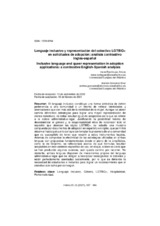Mostrar el registro sencillo del ítem
Lenguaje inclusivo y representación del colectivo queer en solicitudes de adopción: análisis contrastivo inglés-español
| dc.contributor.author | Rodríguez-Arcos, Irene | |
| dc.contributor.author | González Díaz, Andrea | |
| dc.date.accessioned | 2022-11-14T17:14:09Z | |
| dc.date.available | 2022-11-14T17:14:09Z | |
| dc.date.issued | 2021 | |
| dc.identifier.issn | 1579-9794 | |
| dc.identifier.uri | http://hdl.handle.net/10396/24334 | |
| dc.description.abstract | El lenguaje inclusivo constituye una forma simbólica de definir pertenencia a una comunidad o un intento de reflejar identidades y orientaciones que van más allá de la visibilidad de la mujer. Aunque se abren camino diferentes estrategias para lograr una mayor representación de ciertos colectivos, no todas resultan igual de aceptables en lo que se refiere a la esfera administrativo-legal. Justificando la posibilidad teórica de desestabilizar el género y la responsabilidad ética de reconocer todo el espectro que abarcan las siglas LGTBIQ+, se estudia una muestra compuesta por documentos de adopción en español y en inglés, que permitirá observar hasta qué punto se logra contemplar la presencia de una comunidad que es susceptible de tener que recurrir a estos instrumentos legales. Además de comprobar la efectividad de las estrategias utilizadas en ambas lenguas con propuestas fundamentadas desde el plano de la Lingüística, como la de Grijelmo, se reflexionará acerca de qué fórmulas resultan aceptables en este contexto específico de uso, en el que, si bien es cierto que se han producido algunos avances, aún queda camino por recorrer. No obstante, ambas lenguas disponen de mecanismos propios del lenguaje administrativo-legal que no obligan a incorporar neologismos ni dobletes y están perfectamente asentadas socialmente, por lo que se defiende la necesidad de estudiarlas e incluirlas para lograr un reconocimiento que el colectivo aún lucha por conseguir. | es_ES |
| dc.description.abstract | Inclusive language represents a symbolic way of defining the belonging to a community or an attempt to reflect identities and orientations beyond the visibility of women. Although some strategies are starting to be used in order to achieve a more accurate representation of some groups, not all of them are totally acceptable in administrative and legal fields. By justifying the theoretical possibility of destabilizing gender and the ethical responsibility of acknowledging the whole spectrum included in the LGBTIQ+ denomination, this paper studies a corpus of adoption applications in Spanish and English, which allows to explore to which extent the LGBTIQ+ community is represented, a social group who may experience the adoption process. Validating the effect of the particular use of inclusive language in both languages, resorting to studies from Spanish Linguistics such as Grijelmo’s, the paper will also analyse formulas which may be acceptable in this specific context of use, where some advances have been made, but deeper research is needed. However, both languages have their own mechanisms, belonging to the administrative-legal context of use, which do not force speakers to include neologisms or artificial formulas, and are socially accepted: this is why there is a need to study and use them to achieve a representation which the LGBTIQ+ members are still fighting to see. | es_ES |
| dc.format.mimetype | application/pdf | es_ES |
| dc.language.iso | spa | es_ES |
| dc.publisher | UCOPress | es_ES |
| dc.rights | https://creativecommons.org/licenses/by/4.0/ | es_ES |
| dc.source | Hikma 20(1), 157-184 (2021) | es_ES |
| dc.subject | Lenguaje inclusivo | es_ES |
| dc.subject | Género | es_ES |
| dc.subject | LGTBIQ+ | es_ES |
| dc.subject | Hospitalidad | es_ES |
| dc.subject | Performatividad | es_ES |
| dc.subject | Inclusive language | es_ES |
| dc.subject | Gender | es_ES |
| dc.subject | Hospitality | es_ES |
| dc.subject | Performativity | es_ES |
| dc.title | Lenguaje inclusivo y representación del colectivo queer en solicitudes de adopción: análisis contrastivo inglés-español | es_ES |
| dc.title.alternative | Inclusive language and queer representation in adoption applications: a contrastive English-Spanish analysis | es_ES |
| dc.type | info:eu-repo/semantics/article | es_ES |
| dc.relation.publisherversion | https://www.uco.es/ucopress/ojs/index.php/hikma/index | es_ES |
| dc.rights.accessRights | info:eu-repo/semantics/openAccess | es_ES |

